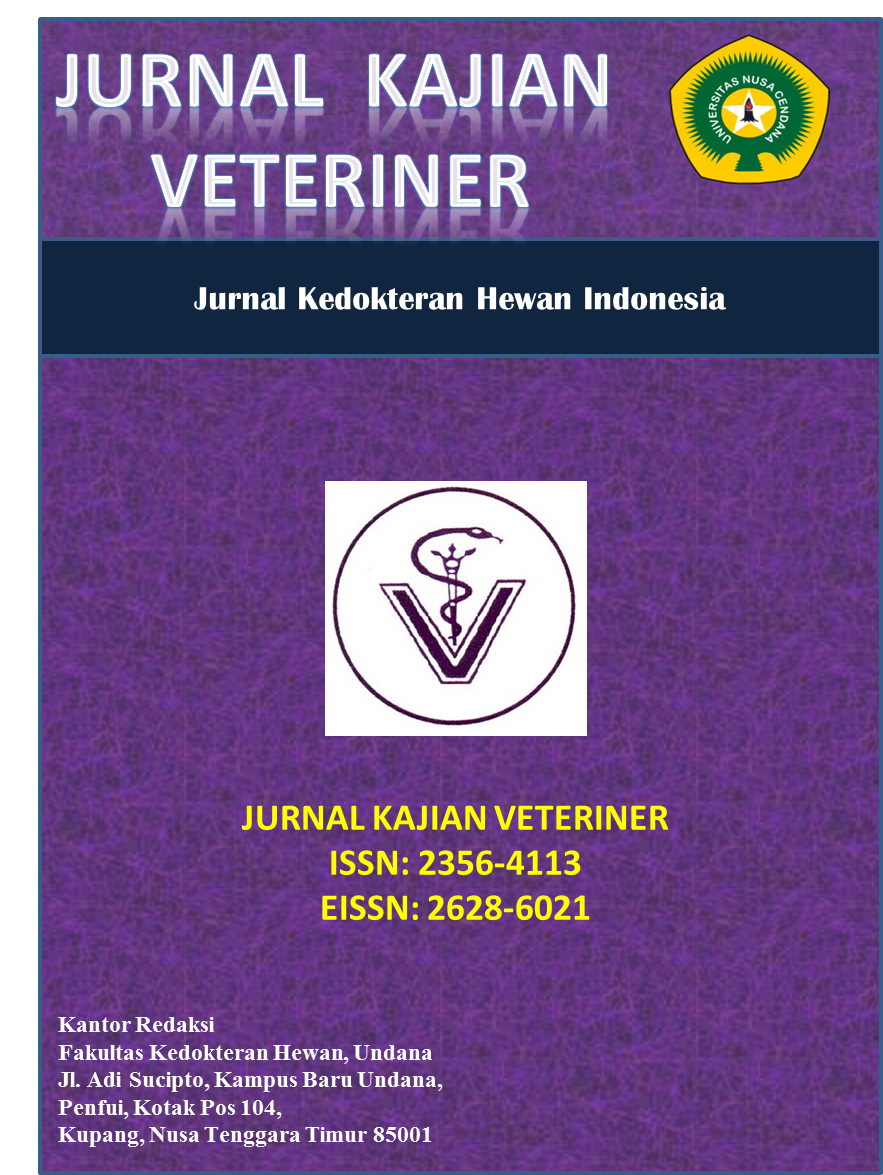Profil Eosinofil Sapi Sumba Ongole yang Diberikan Pakan Tepung Kelor (Moringa oleifera Lam.)
Abstract
Moringa oleifera Lam contains protein compounds, vitamin A, minerals, essential amino acids, antioxidants, and flavonoids, and has an impact on the hematological profile. Based on the evaluated phytochemical, The aim of this study was to identify the eosinophil image of Sumba Onggle Cattle fed with moringa. The research was started from March to September 2017. The research was carried out was in the Integrated Dry Land Laboratory, Nusa Cendana University. and Regional Health Laboratory of East Nusa Tenggara Province. The stages of the research were started with the selection of the sample of the studied cattle (12 adult Sumba Ongole Cattle), the adaptation period, and the duration of treatment of moringa on the cattle for 50 days. The research sample chosen was. The results of the research data showed that the value of eosinophil in the first treatment from 0.32 x 103 / µl to 0.47 x 103 / µl. In contrast to treatment 2 which has a range of eosinophils at a value of 0.04 x 103 / µl to 0.69 x 103 / µl. However, the eosinophil value at the end of the treatment was in the normal range in cattle (0.1 x 103 / µl-1,2x 103 / µl). Eosinophil value data on day 50 showed that eosinophil values tended to increase and in the normal range of eosinophils. These results indicate that the cows fed with moringa showed an eosinophil profile that remained in the normal range.
Downloads
References
Anwar, F., Latif, S., Ashraf, M., & Gilani, A. H. (2007). Moringa oleifera: A food plant with multiple medicinal uses. In Phytotherapy Research (Vol. 21, Issue 1, pp. 17–25). https://doi.org/10.1002/ptr.2023
Chivapat, S., Sincharoenpokai, P., Suppajariyawat, P., Rungsipipat, A., Phattarapornchaiwat, S., & Chantarateptawan, V. (2012). Safety evaluations of ethanolic extract of moringa oleifera lam. Seed in experimental animals. Thai Journal of Veterinary Medicine, 42(3), 343–352.
Do, S. H., Jeong, D. H., Chung, J. Y., Park, J. K., Yang, H. J., Yuan, D. W., & Jeong, K. S. (2008). Eosinophilic myositis in a slaughtered Korean native cattle. Journal of Veterinary Science (Suwǒn-Si, Korea), 9(4), 425–427. https://doi.org/10.4142/jvs.2008.9.4.425
Fozia Farooq. (2012). Medicinal properties of Moringa oleifera: An overview of promising healer. Journal of Medicinal Plants Research, 6(27). https://doi.org/10.5897/jmpr012.279
Hogan, S. P., Rosenberg, H. F., Moqbel, R., Phipps, S., Foster, P. S., Lacy, P., Kay, A. B., & Rothenberg, M. E. (2008). Eosinophils: Biological properties and role in health and disease. In Clinical and Experimental Allergy. https://doi.org/10.1111/j.1365-2222.2008.02958.x
Kapale, P. M., Jagtap, D. G., Badukale, D. M., & Sahatpure, S. K. (2008). Haematological constituents of blood of Gaolao cattle. Veterinary World, 1(4), 113–114.
Kou, X., Li, B., Olayanju, J. B., Drake, J. M., & Chen, N. (2018). Nutraceutical or pharmacological potential of Moringa oleifera Lam. In Nutrients (Vol. 10, Issue 3). https://doi.org/10.3390/nu10030343
Kumar, V. K., Rubha, M. N., Manivasagan, M., Babu, R., & Balaji, P. (2012). Moringa oleifera - The Nature ’ s Gift Abstract : Universal Journal of Environmental Research and Technology, 2(4), 203–209.
McBrien, C. N., & Menzies-Gow, A. (2017). The biology of eosinophils and their role in asthma. In Frontiers in Medicine. https://doi.org/10.3389/fmed.2017.00093
Ogbu, S., Josiah, C., Victor, D., & Author, C. (2017). Haematological Effects of Oral Administration of Aqueous Leaf Extract of Moringa Oleifera in Wistar Rats: Further Evidence of Immunomodulatory Potential. International Journal of Health Sciences & Research (Www.Ijhsr.Org), 7(8), 120. www.ijhsr.org
Paikra, B. K., Dhongade, H. K. J., & Gidwani, B. (2017). Phytochemistry and pharmacology of Moringa oleifera Lam. In Journal of Pharmacopuncture (Vol. 20, Issue 3, pp. 194–200). https://doi.org/10.3831/KPI.2017.20.022
Popoola, J. O., & Obembe, O. O. (2013). Local knowledge, use pattern and geographical distribution of Moringa oleifera Lam. (Moringaceae) in Nigeria. Journal of Ethnopharmacology, 150(2), 682–691. https://doi.org/10.1016/j.jep.2013.09.043
Ravin, K. A., & Loy, M. (2015). The eosinophil in infection. In Clinical Reviews in Allergy and Immunology. https://doi.org/10.1007/s12016-015-8525-4
Sankhalkar, S., & Vernekar, V. (2016). Quantitative and Qualitative analysis of Phenolic and Flavonoid content in Moringa oleifera Lam and Ocimum tenuiflorum L. Pharmacognosy Research, 8(1), 16–21. https://doi.org/10.4103/0974-8490.171095
Shi, H.-Z. (2004). Eosinophils function as antigen-presenting cells. Journal of Leukocyte Biology, 76(3), 520–527. https://doi.org/10.1189/jlb.0404228
Suzana, D., Suyatna, F. D., Azizahwati, Andrajati, R., Sari, S. P., & Mun’im, A. (2017). Effect of moringa oleifera leaves extract against hematology and blood biochemical value of patients with iron deficiency anemia. Journal of Young Pharmacists, 9(1), S79–S84. https://doi.org/10.5530/jyp.2017.1s.20
Tende, J. A., Ezekiel, I., Dikko, A. A., & Goji, A. D. T. (2011). Effect of Ethanolic Leaves Extract of Moringa oleifera on Blood Glucose Levels of Streptozocin-Induced Diabetics and Normoglycemic Wistar Rats. Br. J. Pharm. Toxicol., 2(1), 1–4.
Vergara-Jimenez, M., Almatrafi, M. M., & Fernandez, M. L. (2017). Bioactive components in Moringa oleifera leaves protect against chronic disease. In Antioxidants (Vol. 6, Issue 4). https://doi.org/10.3390/antiox6040091
Copyright (c) 2021 JURNAL KAJIAN VETERINER

This work is licensed under a Creative Commons Attribution-NonCommercial-NoDerivatives 4.0 International License.

 Frans Umbu Datta(1*)
Frans Umbu Datta(1*)








.png)


